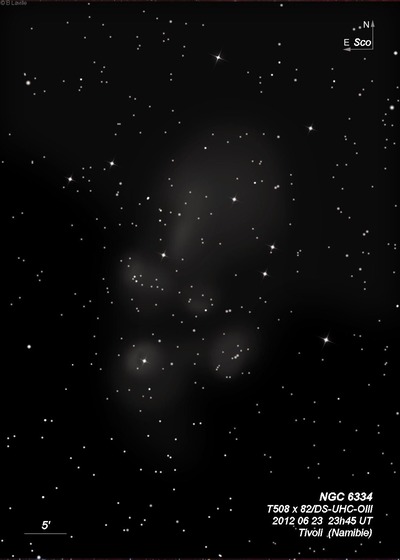
John Herschel discovered NGC 6334 = h3678 on 7 Jun 1837 and recorded "pB; vL, v irr oval, in which, though eccentric is a *8, whose place is that taken. One side of the neb is brighter than the other." The next night he called this nebula "vF; vL; vglbM; 5'x4', out of M is a *8.9 or 9 mag, whose place is taken. The densest part of the nebula follows this star 4.5 sec on the same parallel."
Massive HII region/molecular cloud complex with five distinct centers of massive star formation.
The nickname "Cat's Paw" apparently is from astrophotographer Jerry Lodriguss. He writes "I believe that I was also the one who actually gave the "Cat's Paw" nebula its popular name. I started calling it that because of its resemblance to, of all things, a cat's paw (!), and because of its proximity to the "Cat's Eyes", Lambda and Upsilon Scorpii. I think the name was first published in an article I wrote in Sky and Telescope magazine in August of 1998, and documented in Hartmut Frommert's "A Collection of Some Common Names for Deep Sky Objects" on the SEDS web site."
300/350mm - 13.1" (7/5/83): fairly easy nebulosity surrounds mag 8 star with UHC filter and extends 30' N. This is an unusually large nebulosity, mostly visible surrounding stars and includes a close faint triple star.
400/500mm - 18" (7/17/07): The "Cat's Paw Nebula" is a fascinating HII complex and molecular cloud (RCW 17) with several distinct sections. At 73x and OIII or UHC filter, the brightest section or toe is on the southeast side (NGC 6334 = Gum 62) and consists of a 4'-5' glow extending mostly north of a mag 8.5 star (HD 156738) at 17 20.9 -36 04 (2000). The nebulosity appears weaker on the SW side of the star and slightly brighter wrapping around the eastern side of the star. John Herschel only described this section of the entire RCW 127 complex.
A second large section or toe forming the southwest component (VdBH 86 = Gum 61) lies 13' to the west and consists of a faint, 5' glow involving a 17" pair (HD 319703 at 17 19.8 -36 06). This piece is asymmetric and appears as a broad fan sweeping north to SE from the central stars and is very weak or nonexistent to the SW of the stars.
A group of smaller pieces forming the northeast toe (Gum 64b) is 12'-15' N of the brighter SE section. First is an obvious 2' glow surrounding a mag 10 star (HD 319702 at 17 20.8 -35 52. A small, faint knot of nebulosity lies 3' W, no more than 1' in diameter. This knot is also situated 2' SSE of a mag 9.5 star that is free from nebulosity. But to the NW of this star another few arc minutes is a third detached piece of nebulosity (brightest part of Gum 64c), ~2' in diameter. Very weak nebulosity appears to connect the NE section (Gum 64b) with the SE section (Gum 62).
Finally, midway between Gum 64b and Gum 61 a small extremely faint detached glow (Gum 64a) was glimpsed close SE of a mag 11 star at 17 20.1 -35 57.
Notes by Steve Gottlieb